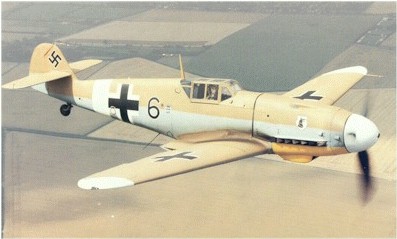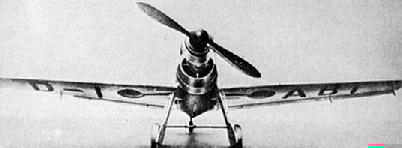The Internet Museum of World War II Aviation | home
Germany | Arado Ar 68 | Arado Ar 234 | Bachem Ba 349 | BV40 | BV 155 | Dornier Do 335 | Fw 187 Falke | Fw 189 Uhu | Fw 190 | Fw Ta 152 | Fw Ta 154 | Heinkel He 51 | Heinkel 100 | Heinkel 112 | Heinkel 113 | Heinkel 162 | Heinkel 219 | Heinkel 280 | Henschel 123 | Junkers Ju88 | Junkers Ju388 | Bf 109 | Bf 110 | Me 210 | Me 410 | Me 163 Komet | Me 262 | Me 263 | Me 328
Messerschmitt Bf 109
It began as an unwanted fighter designed by a relatively new company, but eventually the Bf 109 would become the fighter that all Others from World War Two would be compared against. Today, with all the aid of hindsight, we can see that the Bf 109 was undoubtedly amongst the top five greatest war aircraft in history. More Bf 109s were built than all the P-51 and P-47s combined, and they composed over 60% of the German Luftwaffe fighters during 1936-1945. At the time of its early development, the Bf 109 was probably, although in close competition with the Supermarine Spitfire, the most advanced flying war machine in the world.
The Bf 109s main enemy in the early days of the war was aircraft of the RAF, and here it is amusing to note that the first engine for the prototype Bf 109 was a Rolls Royce Kestrel engine of 700hp. It was designated the Bf- I 09V I and it flew in official German tournaments against the He I 12. Unfortunately, despite the faster speed of the Bf 109V, the test pilots were partial to the He 1 12 because of its wider landing gear. But the He 1 12 had early development problems and because of this it was the Bf 109 that would become the cheif fighter of pre- and early World War Two.
This development was in the early 1930s, going on into 1935. In the late months of 1935, the initial artnament of two 7.92mm MG17s was upgraded to three MG17s, and finally the first production armament of one 20-mm cannon and two 7.92mm machine guns. What was highly interesting is not the fact that the guns were all clustered in the nose. At that time, most fighters were striving for highly centralized armaments, usually in the nose, to provide a tight grouping of destruction. What was interesting was that the 20-mm cannon fired through the hollow crankshaft of the Vee inline engine and out through the center of the propeller hub. About this time the Rolls Royce Kestrel engine was replaced by the Junkers Jumo 210 A of 80 less horse power. Overall performance was still rather equal . because the Kestrel had a large lower radiator and high-jutting nose that created tremendous drag. After the installation of the Junkers Jumo the nose was redesigned and drag substantially reduced, giving the Bf 109 its popular streamlined-nose appearance it would beome famous with. Later in the development, about 1936, the Jumo 210 Awas deemed not powerful enough and a Daimler Benz DB 600 1,000hp was installed, giving the Bf 109 better performance than most any other fighter in the world.
Production began in mid 1936, with substantial orders coming in almost immediately. The Bf 109E saw combat in the Spanish Civil War,, ripping up those sent up to encounter it. Indeed, the Spanish war was the testing time of Nazi Gennanys new war machine, and perhaps most importantly, their new and highly advanced aircraft. Again equipped with a new engine, the Bf 109 set a new speed record in 1937 with a speed of 379.4mph. When the Second World War began with the invasion of Poland and France,, the Bf 109 showed its superiority to the world, flaming with ahnost equal ease the PZL and Bloch fighters sent up by the defending countries.
The scourge of the Bf 109 was its thin and closly separated landing gear, which plagued the Bf 109 for its entire career. They would snap and bend on hard landings and made the fighter very unstable on the ground while taxiing. More Bf 109s were grounded from landing gear damage than from enemy fire. Also there was severe lateral control problems at high speed, and in fact the wing slats often opened up in high-stress combat maneuvres. This avoided the feared Bf 109 stall,, but it affected the ailerons and would disturb the pilots' aim.
Armament was heavy in the later fighters, even on the E model 3 20-mms were considered standard. Wing guns also became popular, and they were fitted either in the wing itself or in removable packs on the underside. Some were given underwing mortars and R4M air-to-air unguided missiles.
With the arrival of the later versions of the Supermarine Spitfire in the Battle of Britain, and eventually the arrival of advanced American machines, the dauntless Bf 109 began at last to become outdated. More newer designes of the Bf 109 came out and were produced in prodigious numbers, but this failed to stop the gradual dominance the new Allied fighters were bringing. Largly the reason for this failure of the Bf 109 to keep pace with its Allie competitors was not the aircraft itself, rather the pilots that flew it. Germany was pitifully short of experienced pilots by 1944, and the green trainees send up in the new versions of the 109 were shot down in flaming droves.
The Bf 109H employed wide, inwards retracting landing gear, solving the problem of landing and taxiing, but its production came too late and its effects were to little to be of any significant value to the Third Reich.


Clearly visible here is the very thin landing gear
that plagued the Bf 109 until the H model.
Many More Photographs/pictures of the Bf 109 are in the Photograph Gallery